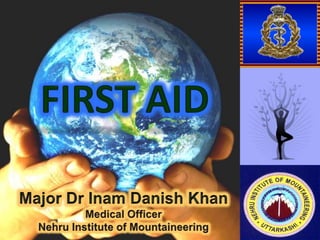
FIRST AID (BASICS & CPR)-Maj Dr ID Khan
- 1. FIRST AID Major Dr Inam Danish Khan Medical Officer Nehru Institute of Mountaineering
- 2. BUT WHY DO I NEED TO LEARN FIRST AID How does it feel if you lose a loved one? DON’T STAND IN SHOCK RESPECT LIFE PARTICIPATE IN SAVING LIVES
- 3. FIRST AID First Aid is the initial assistance given to a casualty from the moment of the accident until availability of specialized medical care by a doctor.
- 4. THE HUMAN BODY ROCKET SCIENCE IS EASY IF YOU DARE THINK ABOUT HUMAN BODY It is a complex real life playground. A thousand structures with varied functions. A billion biomolecules and a million reactions. Still counting on doctors for the unexplored. Entropy does not increase - Open system. Laws of physics are applied as well as defied.
- 5. Robot Human
- 6. HUMAN vs robot See, Hear, Smell, Taste Walk, Eat, Drink, Speak, Breathe, Cry Feel touch, temperature, pain, vibration Feel good or bad if you talk about it in third person Emote (Show fear, anger, sadness, happiness, love) Study to become wise, Give a lecture Make friends Have recollections of its past or plan its future Apply logic and reason situations to decide Think Memorize Reproduce Grow Can a Robot?
- 11. NERVOUS SYSTEM
- 12. DIGESTIVE system
- 13. PROLOGUE First Aid : Definition, types and duties Disasters and Triage Vital signs of life : Pulse, Temp, BP, Resp Life Support : Artificial Respiration & CPR Casualty Evacuation
- 14. FIRST AID AIM Preserve life Prevent worsening of condition Promote recovery CARDINAL RULES Ladies to be examined in attendance Never label a person “Malingerer” 3. Benefit of doubt goes to the patient
- 15. TYPES OF FIRST AID Basic First Aid Wilderness/ Outdoor First Aid Mountain/ High Altitude First Aid Military/ Battlefield First Aid Aquatic/ Marine First Aid Hyperbaric/ Diving First Aid
- 16. Duties of first aider Assess condition quickly Check your safety Call for help Protect others from danger Prioritise – Do triage Give prompt first aid Arrange casualty evacuation Remain with the patient till attended by doctor and help him afterwards
- 17. DISASTER A disaster is present when need exceeds resources! MASS CASUALTY INCIDENT MAN-MADE Fires Firearms Air, Water Rail, Road Industrial Explosions Building collapse Atomic bombs Terrorist Attacks NATURAL Earthquakes/landslides Avalanche Volcanoes Tornado/Hurricanes Floods Fires Tsunami Meteors
- 18. TRIAGE Triage is the dynamic process of prioritizing casualties for treatment and evacuation of the wounded within the limitations of the situation and resources
- 19. TRIAGE PRIORITIES 1. You - Get out of danger 2. Life – Check ABC, stop bleeding 3. Disability - Limb/Eye sight APPROACH People walking to you – Least priority (Priority 3) People who can move but can’t walk – Priority 2 No action – Cry for help (Priority 1)
- 20. VITAL SIGNS OF LIFE Breathing 12-20 breaths/min Pulse 60-100 beats/min Bld pressure 100/60 - < 140/90 mm Hg 4. Temperature 370C 98.6 F 5. Capillary return 2-3 seconds 6. Cyanosis
- 21. BREATHING Don’t tell the patient Observe chest movements abdominal movements Put your ears to nose Normally 12-20/min Can increase in mountains
- 23. PULSE
- 24. BLOOD PRESSURE
- 25. TEMPERATURE Below tongue Axilla in kids 370C 98.6 F Pulse increases with increasing temperature
- 26. CAPILLARY RETURN Assess blood supply in limbs Check at fingers and toes of both sides Normal capillary return 2-3 secs
- 27. CYANOSIS Bluish discoloration of body Reduced oxygen in blood First seen in nail beds, ear lobes, lips If tongue goes blue – life threatening Never smoke at higher altitudes
- 28. LIFE SUPPORT A – AIRWAY & NECK FRACTURE B – BREATHING & CYANOSIS C – CIRCULATION & BLEEDING CONTROL D – DYSFUNCTION OF NERVOUS SYSTEM E – EXPOSURE & EVACUATION
- 29. LIFE SUPPORT A – Talk with patient --- Head tilt and chin lift B – Check rate of breathing and cyanosis C – Check pulse, BP and capillary return Bleeding – Pressure, elevate, bandage D – Eye/Speech/Body Movements A- Alert V- Response to Voice P- Response to Pain U- Unresponsive
- 30. ARTIFICIAL RESPIRATION Required when patient is not breathing Exhale air in a patients chest Mouth to Mouth Mouth to Nose
- 31. CARDIO PULMONARY RESUSCITATION Revive the cardio-respiratory system
- 32. CARDIO PULMONARY RESUSCITATION Chest Thump Give 15 chest compressions Give 2 mouth to mouth breaths 15:2 ratio to be followed Continue for 15/45 mins
- 33. CASUALTY EVACUATION PRINCIPLES OF EVACUATION Evacuate only if fit for evacuation Foresee peak evacuation period and be prepared Priority for more seriously ill Due care during evacuation CAS EVAC Evacuation done by non medical people MED EVAC Specialised evacuation by trained medical personnel
- 34. SINGLE PERSON HELP SUPPORT CARRY SADDLEBACK CARRY ARMS CARRY
- 35. SINGLE PERSON HELP FIREMAN’S LIFT PACKSTRAP CARRY
- 36. TWO PERSON HELP TWO MAN SUPPORT CARRY TWO MAN ARMS CARRY
- 37. TWO PERSON HELP FOUR HAND SEAT CARRY FORE & AFT LIFT CARRY
- 38. IMPROVISED STRETCHERS GUNNY BAG BLANKET BELTS
- 39. IMPROVISED STRETCHERS GROUND SHEET SHIRTS ROPE
- 40. AIR AMBULANCE
- 42. Questions
- 43. Thank you